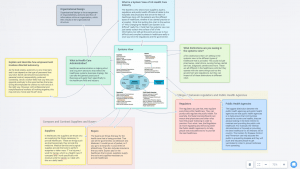Link to map:  https://www.plectica.com/maps/G4AMRWXYF/edit/HI3U6VA22
https://www.plectica.com/maps/G4AMRWXYF/edit/HI3U6VA22
What is healthcare Administration?
Healthcare administration is making short and long term decisions that reflect the healthcare systems business strategy. We can take the general practices of Business and apply them specifically to the healthcare field and industry.
What is a systems view of the US Health Care Industry?
The Systems view shows how suppliers, buyers, regulators and public health officials all relate to the hospitals and physicians that are at the heart of healthcare long with the patients and the different types of healthcare, whether it be a dental practice or a hospital. I think that putting this chart in the section of “Why Changing the Health Care System is So Difficult” really fits. I think that this systems view can just barely scratch the surface of all of the information, but still get the point across as to how difficult and complex business in healthcare really is once you tie in the regulations and the government.
What distinctions are you seeing in the systems view?
A few distinctions that I am seeing in the systems view is the different types of healthcare that is provided. This could include pharmacies, retail clinics, nursing homes, dental services, diagnostic centers and more. These are all different in the healthcare world but they operate with the same things such as the government and regulations, but they can impact all of these distinctions in different ways.
What distinctions are you not seeing?
I know I will have to answer this in a later question, but I thinking right off the bat, I am having trouble finding distinctions on the regulators and the public health agencies. They are both working to improve healthcare, aren’t they?
How would you distinguish between regulators and public health agencies?
The biggest distinction between the public health agencies and public health agencies are that public health agencies is to help ensure that communities around the country are healthy, they are always looking in the best interest to maintain and providing the public with healthcare. For example, the Veteran Administration is focused on providing the best healthcare for all Veterans int he country. The Centers for Disease Control and Prevention can help educate the public to preventing disease and they will push and educate people to get vaccinated in order to prevent sickness from spreading. The regulators do just that, they regulate everything within healthcare. They can protect and regulate the public health. For example, the State licensing Boards can ensure that physicians and other roles have the proper licensing in order to practice. From what I see, the Regulators do more regulating and enforcing while the Public Health Agencies try to help people stay educated and try to provide the best healthcare.
Compare and contrast Suppliers and buyers?
In healthcare, the suppliers are those who are supplying the things necessary to provide healthcare. These are things such as pharmaceuticals, they provide the medicine. Medical devices and surgical supplies provide the tools to perform surgeries or take x-rays. IT is a big one, I work for Cerner, which is a Health Care IT company and I work specifically with revenue cycle for Cerner, so I deal with this on a daily basis. The buyers are things that pay for the health care that is being provided. That can be the government, via Medicare and Medicaid. It could be out of pocket, or if you go to a nonprofit, it could even be philanthropy. This also includes insurance that you have. Buyers pay for the healthcare that is given, suppliers supply the tools and supplies necessary to provide healthcare.
What is organizational design?
Organizational design is the arrangement of responsibilities, authority and flow of information within an organization, which then results in the organizational structure.
Explain and describe how empowerment involves directed autonomy.
As the book states, autonomy is very important, and it can depend on the type of personnel that you have. Some can become accustomed to personal control, responsibility, pride and ownership. Once a worker feels that way they can respond positively to the opportunities that arise. Giving the employee the chance to work and do it the right way. However with professional and non professional workers all working together, this may not be a “once size fits all” shoe.

Great job, Sam! Can you post in our Facebook group?